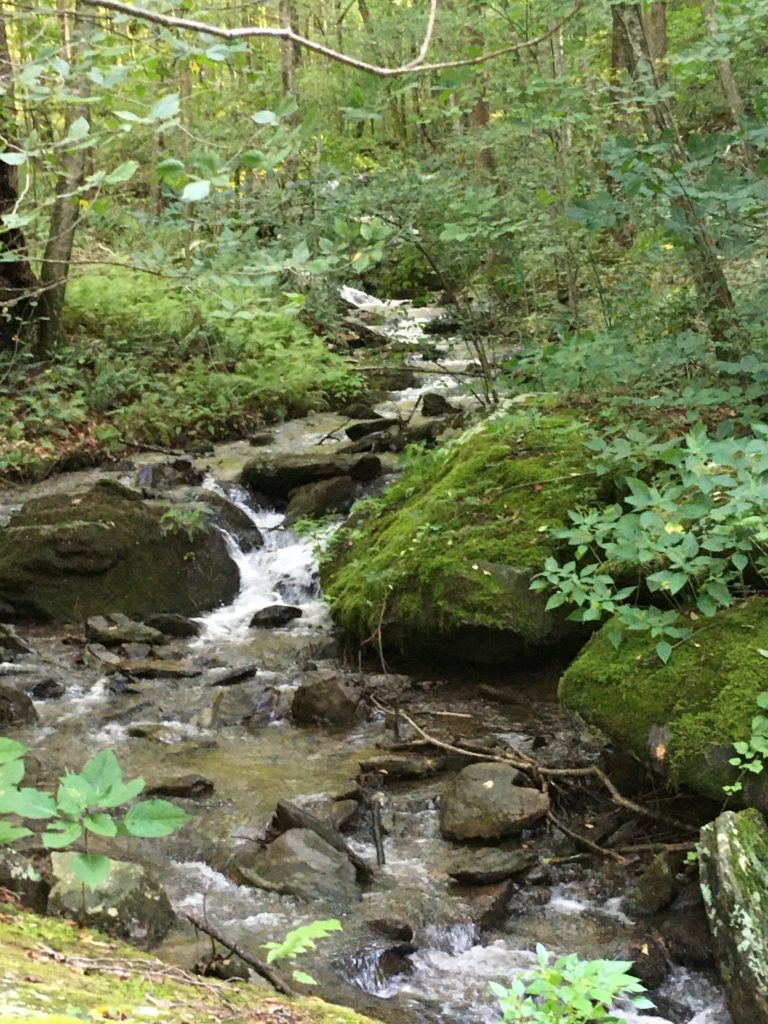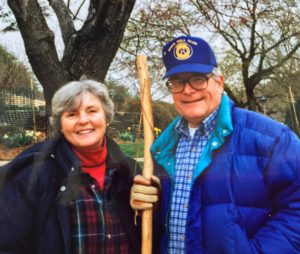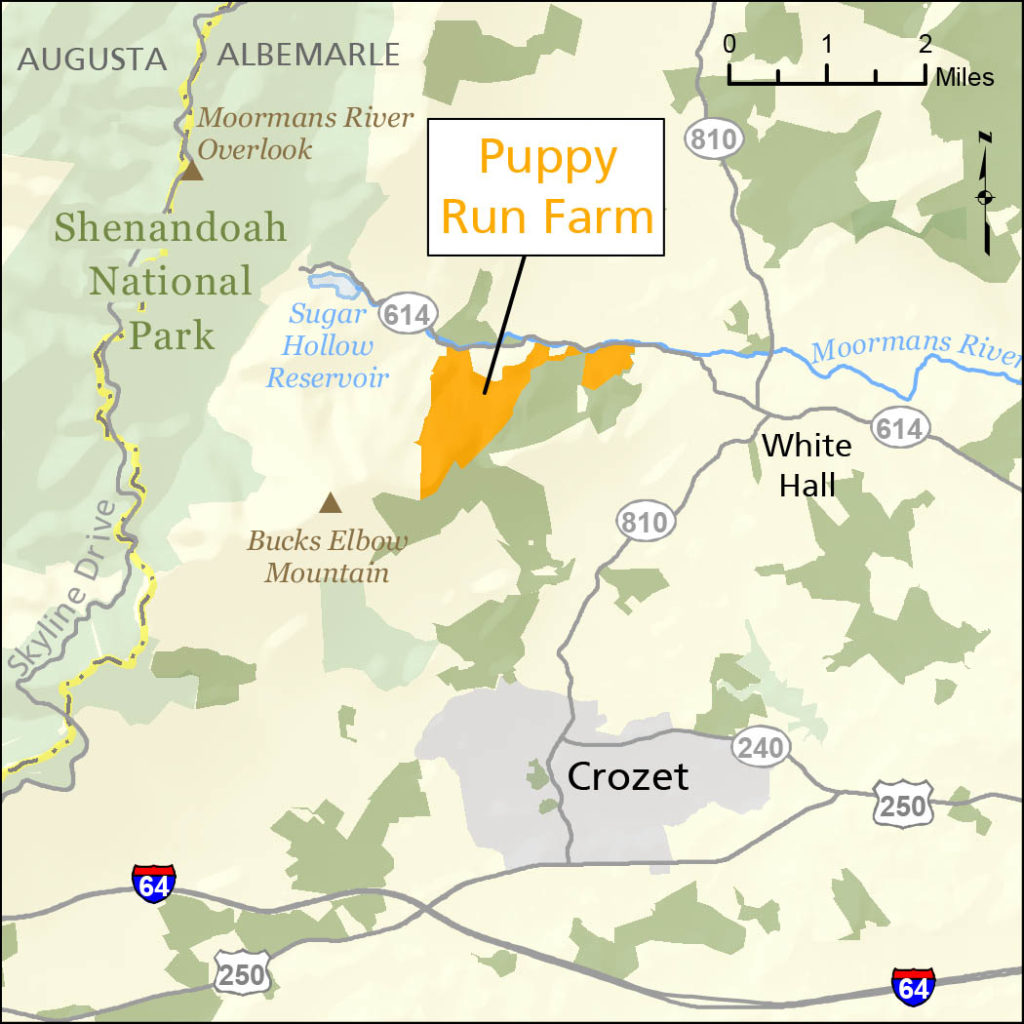An updated easement ensures a family legacy in Albemarle
When Bob and Carroll Gilges retired in 1996 from a life filled to the brim with the adventures and demands of career, raising three daughters, travel, and many moves, they found their slice of heaven in the heavily wooded northern slope of Buck’s Elbow Mountain, mere miles from Shenandoah National Park and along the bank of the Moormans River in Albemarle County’s historic Sugar Hollow and near White Hall.
Puppy Run Farm’s 670 acres of undeveloped splendor can be seen from three miles away at the top of Buck’s Elbow, along the Appalachian Trail and the Moormans River Overlook on Skyline Drive. Hikers driving out to the Sugar Hollow Reservoir Trailhead can view the farm for miles along rural Sugar Hollow Road. The farm fronts more than 3,000 feet of the Moormans River, a designated Virginia Scenic River, which along with other tributaries on the farm—including Puppy Run and Porterfield Branch—supply drinking water for the City of Charlottesville and parts of Albemarle County.

“They just loved it, loved watching the wildlife and birds, loved riding horses and walking and later riding the Gator throughout the property. It’s such a beautiful place,” said the Gilges’ oldest daughter, Peggy, who moved to nearby Ivy in 2004.
Bob reflected on what Puppy Run Farm meant to him in a 2003 article he wrote for The Observer. “My family and I were fortunate to live in several beautiful cities and towns before development sprawl, traffic congestion, and smog claimed them,” he wrote of Atlanta, where his 15-minute commute became an hour, and “back-country” Greenwich, Conn., where huge homes crowded out what had been designated open space. He went on to say, “Upon retirement, we looked for the perfect place, and we chose Charlottesville…Now the question rose of how we could save this beautiful watershed land from future development and the degradation that goes with it?”
Their answer came by way of a landowner presentation by The Piedmont Environmental Council (PEC) and a meeting with Sherry Buttrick of the Virginia Outdoors Foundation (VOF). In short order, they had placed Puppy Run Farm under a conservation easement, forever protecting it from the fate of so many other places they’d lived and loved. “They were so proud to put that sign at the entrance of the farm, that it was conserved property,” Peggy remembers.
Over their 22 years at Puppy Run Farm, the Gilges’ became well known for their conservation mindset, inviting birders to use their trails, purchasing and restoring the nearby 19th-century McAllister farm and log cabin to its former glory, saving the White Hall horse show grounds from development. They also helped form Friends of the Moormans River, which successfully pressed the local water and sewer authority to restore stream flows from Sugar Hollow Reservoir into the river to sustain the natural ecosystem. “They were very keen on our little village and our river and those lovely views. They wanted to keep it undeveloped and rural and were committed to keeping the character of the place,” Buttrick said

Tragically, in 2018, just shy of their 58th anniversary, Bob and Carroll’s lives were cut short when their car was swept into Ivy Creek during a flash flood. The future of Puppy Run Farm fell into the hands of Peggy and her sisters Emily and Ellen. With lives, careers, children and grandchildren elsewhere, the three have made the difficult decision to sell the farm. But they wanted to honor their parents’ legacy and be absolutely sure that Puppy Run Farm forever remains the beautiful, natural slice of heaven Bob and Carroll fell in love with.
Turning to VOF as their parents did years before, in March 2020, they strengthened and updated the conservation easement on Puppy Run Farm, “making sure it’s strong enough to stand up to the times and really protect the property,” Peggy said.
Conservation easements are attached to a property forever, so why strengthening an easement might be necessary is not always obvious. “There is temptation and risk in writing an easement with the current landowner and conditions in mind. And yet, a piece of land is a dynamic, changing thing. The trees will continue to grow. Waters will continue to move. The land will most certainly change hands,” said VOF Deputy Director Leslie Grayson. “When we look back, we see that easements went through a period of time when they were more specific. Now we know that more restrictions aren’t necessarily better, but they need to be the most effective, essential ones. We’ve also learned a lot about how to reduce ambiguities that could jeopardize the original landowner’s intentions,” Grayson said.
For example, it’s not uncommon in conservation easements that landowners reserve more development rights than they end up needing or using during their lifetime, later realizing that if all those rights are eventually exercised by subsequent owners, the results will not be what they intended, she said. The original easement on Puppy Run Farm allowed four divisions of the land and a total of 15 dwellings. “Mom and Dad wanted to leave open the option that we might all have homes here together, but they would not have wanted it to be carved up into separate parcels with roads put in and new septic systems all over,” Peggy said. The new easement allows for just one division and six dwellings, capping the collective footprint of all buildings at a half-percent of the total land area.
Another reason to update an easement is to account for much that’s been learned in the last two decades about land management and water protections as well. “The Chesapeake Bay Agreement of 2000 began to place responsibility on the Commonwealth to protect water quality; conservation organizations like VOF and PEC have realized this is part of our stewardship work. Easements now include strategies for managing forests and improving water quality in streams, rivers, and wetlands,” said PEC Conservation Director Mike Kane.
“Mom and Dad looked at the woods as wildlife and bird habitat, not as a resource for wood. They didn’t want clear-cutting, and they always tried to protect the trees. They appreciated the pristine quality of the water coming off Bucks Elbow Mountain and how rivers serve as wildlife corridors. So we really locked down the wording to protect the forests and streams and added Puppy Run and Porterfield Branch into the easement, as well as Moormans River,” Peggy said.

The new easement also better protects the viewshed that Bob and Carroll loved so much, taking the highest point of the farm on Bucks Elbow, as well as frontage along Sugar Hollow Road, out of consideration for development.
“Enhancing the easement, we felt, was the perfect way to honor our parents’ memory and their love of this place they called home for 22 years. They really cared about this place—the farm, the river, Sugar Hollow, all of it. And because they loved it so much, they felt a responsibility to protect it in perpetuity. I am hopeful that it will remain as beautiful as it is today far into the future. I know they would be grateful,” Peggy said.
Kane adds that an updated easement not only ensures a legacy, but produces tremendous public benefit in the process. Perhaps Bob Gilges said it best in the 2003 Observer article: “Albemarle County and other rural communities in Virginia are beginning to feel the impacts of overpopulation and overbuilding… in the form of traffic impasses, waste disposal problems, increased air and water pollution, loss of scenic vistas, farmlands and forests, water shortages and more. Our secret weapon is the land conservation easement. Virginians owe it to future generations to look into easements and talk about the idea with neighbors, family and community members. You can do it, and if you do, Virginia still has a chance.”
If you own land that is under easement and would like to learn more about strengthening that easement, please contact PEC or VOF staff who can help you initiate that process.
This article appeared in The Piedmont Environmental Council’s member newsletter, The Piedmont View. If you’d like to become a PEC member or renew your membership, please visit pecva.org/join.
